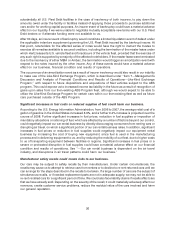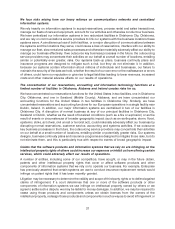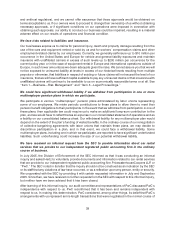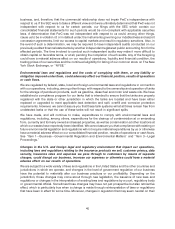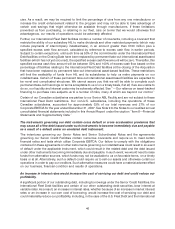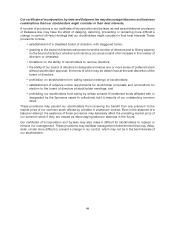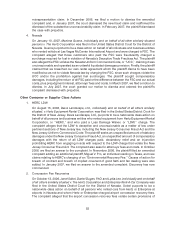Hertz 2007 Annual Report Download - page 66
Download and view the complete annual report
Please find page 66 of the 2007 Hertz annual report below. You can navigate through the pages in the report by either clicking on the pages listed below, or by using the keyword search tool below to find specific information within the annual report.cars. As a result, we may be required to limit the percentage of cars from any one manufacturer or
increase the credit enhancement related to the program and may not be able to take advantage of
certain cost savings that might otherwise be available through manufacturers. If these limitations
prevented us from purchasing, or retaining in our fleet, cars on terms that we would otherwise find
advantageous, our results of operations could be adversely affected.
Further, our International Fleet Debt facilities contain a number of covenants, including a covenant that
restricts the ability of our subsidiary HIL to make dividends and other restricted payments (which may
include payments of intercompany indebtedness), in an amount greater than e100 million plus a
specified excess cash flow amount, calculated by reference to excess cash flow in earlier periods.
Subject to certain exceptions, until such time as 50% of the commitments under the International Fleet
Debt facilities on the Closing Date have been replaced by permanent take-out international asset-based
facilities (which has not yet occurred), the specified excess cash flow amount will be zero. Thereafter, this
specified excess cash flow amount will be between 50% and 100% of excess cash flow based on the
percentage of facilities relating to the International Fleet Debt facilities at the closing of the Acquisition
that have been replaced by permanent take-out international asset-based facilities. These restrictions
will limit the availability of funds from HIL and its subsidiaries to help us make payments on our
indebtedness. Certain of these permanent take-out international asset-based facilities are expected to
be novel and complicated structures. We cannot assure you that we will be able to complete such
permanent take-out financings on terms acceptable to us or on a timely basis, if at all; if we are unable to
do so, our liquidity and interest costs may be adversely affected. See ‘‘—Our reliance on asset-backed
financing to purchase cars subjects us to a number of risks, many of which are beyond our control.’’
Certain of our Canadian subsidiaries are parties to our Senior ABL Facility and are not subject to these
International Fleet Debt restrictions. Our non-U.S. subsidiaries, including the operations of these
Canadian subsidiaries, accounted for approximately 33% of our total revenues and 27% of our
Corporate EBITDA for the year ended December 31, 2007. See Note 9 to the Notes to our audited annual
consolidated financial statements included in this Annual Report under the caption ‘‘Item 8—Financial
Statements and Supplementary Data.’’
The instruments governing our debt contain cross default or cross acceleration provisions that
may cause all of the debt issued under such instruments to become immediately due and payable
as a result of a default under an unrelated debt instrument.
The indentures governing our Senior Notes and Senior Subordinated Notes and the agreements
governing our Senior Credit Facilities contain numerous covenants and require us to meet certain
financial ratios and tests which utilize Corporate EBITDA. Our failure to comply with the obligations
contained in these agreements or other instruments governing our indebtedness could result in an event
of default under the applicable instrument, which could result in the related debt and the debt issued
under other instruments becoming immediately due and payable. In such event, we would need to raise
funds from alternative sources, which funds may not be available to us on favorable terms, on a timely
basis or at all. Alternatively, such a default could require us to sell our assets and otherwise curtail our
operations in order to pay our creditors. Such alternative measures could have a material adverse effect
on our business, financial condition and results of operations.
An increase in interest rates would increase the cost of servicing our debt and could reduce our
profitability.
A significant portion of our outstanding debt, including borrowings under the Senior Credit Facilities, the
International Fleet Debt facilities and certain of our other outstanding debt securities, bear interest at
variable rates. As a result, an increase in interest rates, whether because of an increase in market interest
rates or an increase in our own cost of borrowing, would increase the cost of servicing our debt and
could materially reduce our profitability, including, in the case of the U.S. Fleet Debt and the International
46


